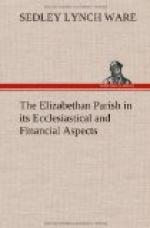That the keeping of cattle was a well-recognized source of parish income is seen by the Queen’s Injunctions of 1559 in which she alludes to “the profit of cattle” among other sources of parish revenue to be devoted to the poor, “and if they be provided for, then to the reparation of highways next adjoining,” or to the repair of the church.[224]
Leaving the topic of general endowments to take up those sources of revenue destined to defray particular forms of expenditure, we find that Permanent Parish Endowments in lands, goods or money devoted to the defraying of Specific Parish Administrative Burdens or Utilities were very numerous in the local documents of the 16th century. Sometimes a land or fund was set apart by the donor, or by the parish itself, for the support of a parish servant or officer;[225] sometimes its revenue maintained this or that cripple or blind man,[226] or a number of them; sometimes it was used for feeding the poor,[227] or for buying wearing apparel for them;[228] for setting them at work in houses of correction,[229] or for parish education.[230]
In particular, lands or funds were frequently set apart as special and permanent endowments for the repair of bridges.[231] In fact, the proceeds of parish lands or other endowments might be appropriated to alleviate any tax burden whatsoever. In 1549 it was stated by the wardens of North Elmham, Norfolk, that the net proceeds of the five and thirty or forty acres which they rented out were devoted exclusively towards the paying of the fifteenths due from time to time to the king and his successors.[232]
To illustrate the variety of purposes for which parish trusts were created, I cannot do better than quote part of the preamble of the 43 Eliz. c. 4, known as the Statute of Charitable Uses: “Whereas Landes, Tenements, Rentes ... Money and Stockes of Money,” it is there rehearsed, “have bene heretofore given, limitted ... and assigned ... some for Releife of aged, impotent and poore people, some for Maintenaunce of sicke and maymed Souldiers and Marriners, Schooles of Learninge ... some for Repaire of Bridges, Fortes, Havens, Causwaies, Churches, Sea-bankes and Highewaies, some for Educac[i]on and p[re]fermente of Orphans, some for or towardes Reliefe, Stocke or Maintenaunce for Howses of Correcc[i]on, some for Mariages of poore Maides, some for Supportac[i]on, Ayde and Helpe of younge Tradesmen, Handiecraftesmen and p[er]sons decayed, and others ... for aide or ease of any poore Inhabitants conc[er]ninge paymente of Fifteenes, settinge out of Souldiers and other Taxes [etc.]...."[233]
As for money and goods left by testators or given inter vivos for Temporary Expenses or Special Occasions (as opposed to the creation of permanent trusts and endowments), we find a constant stream of such benefactions throughout the Elizabethan period.
By the Queen’s Injunctions of 1559 parsons are diligently to exhort their parishioners, “and especially when men make their testaments,” to give to the poor-box, the surplus of which, after provision for the needy, might be devoted to church and highway repair.[234]




